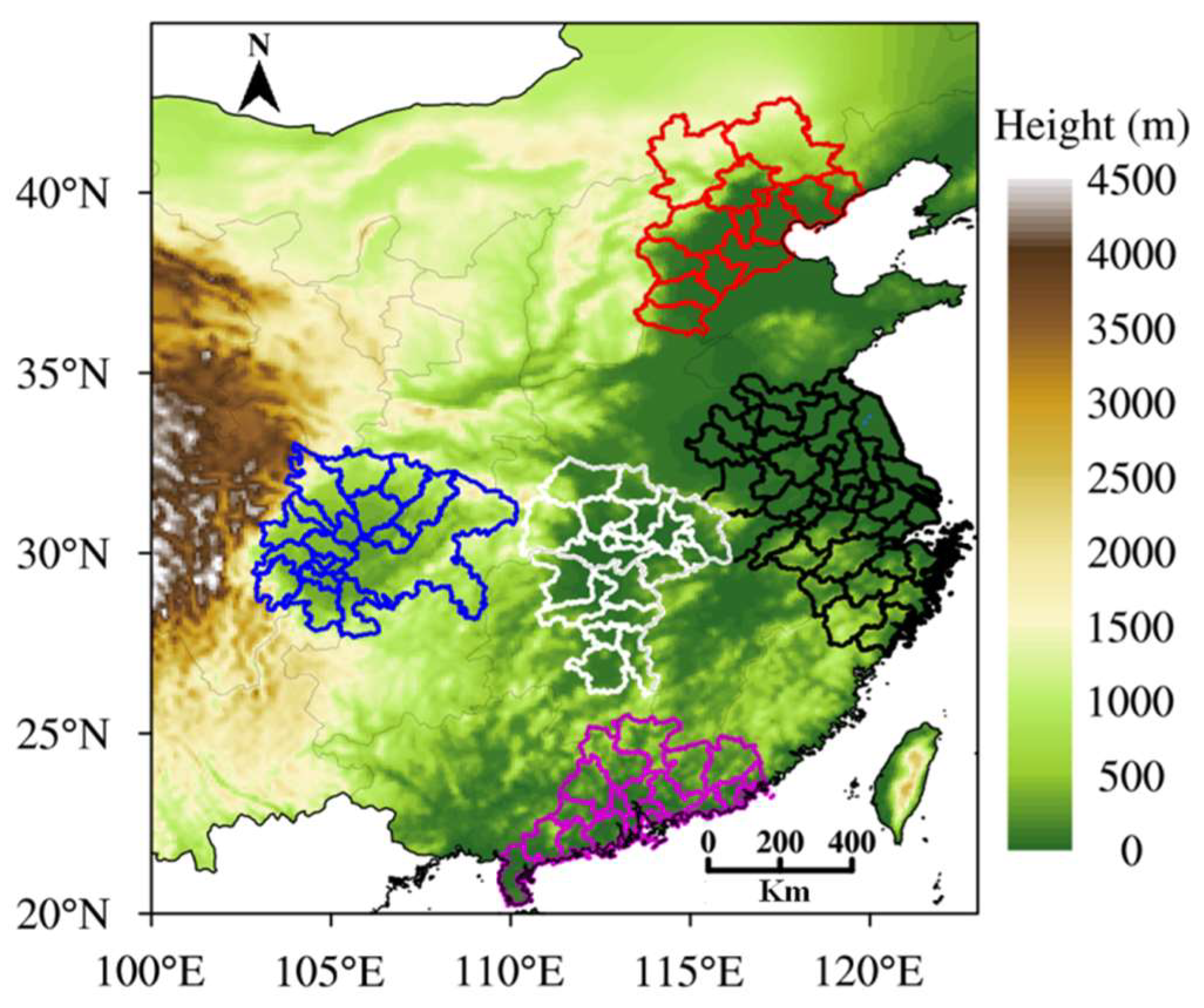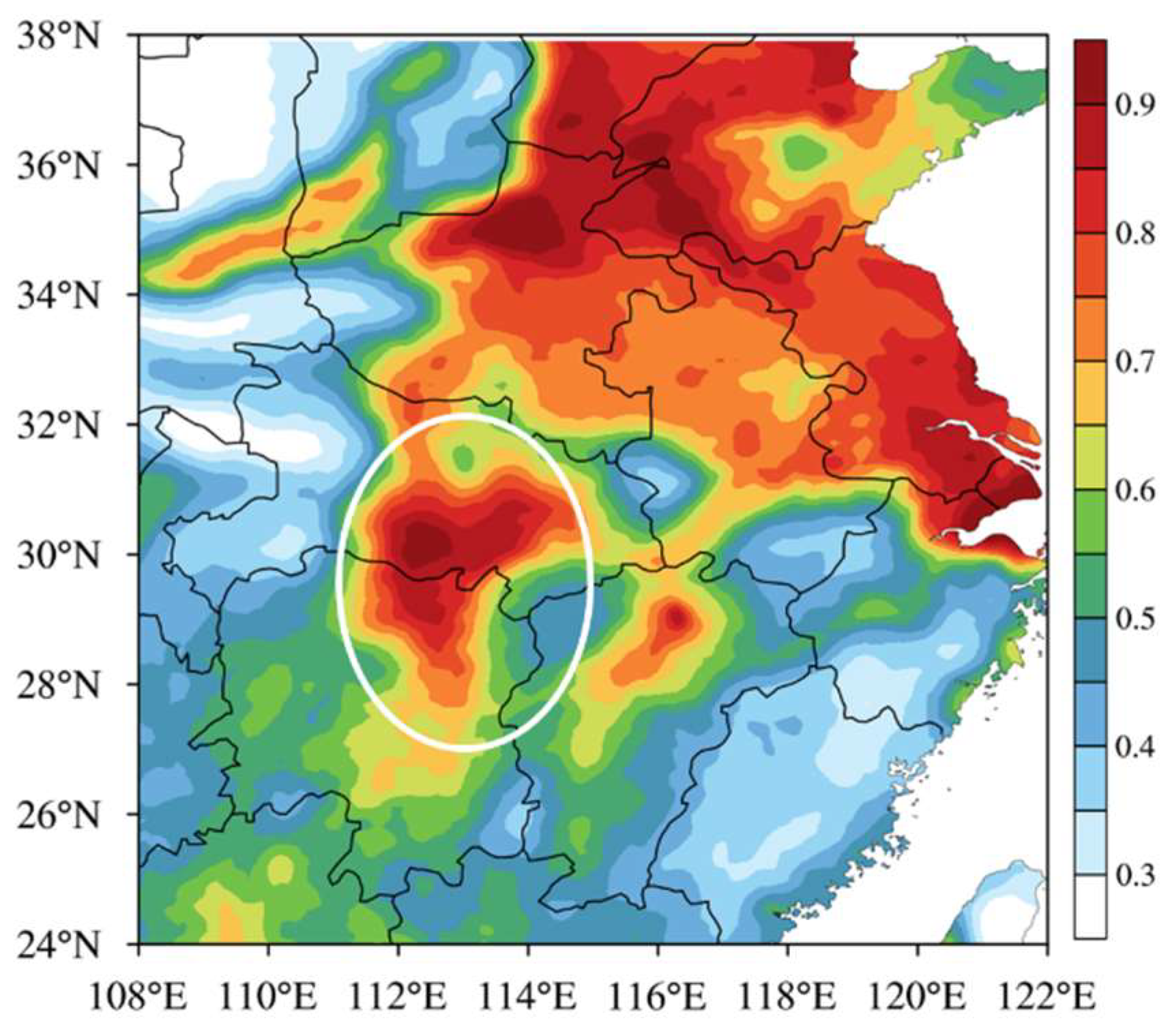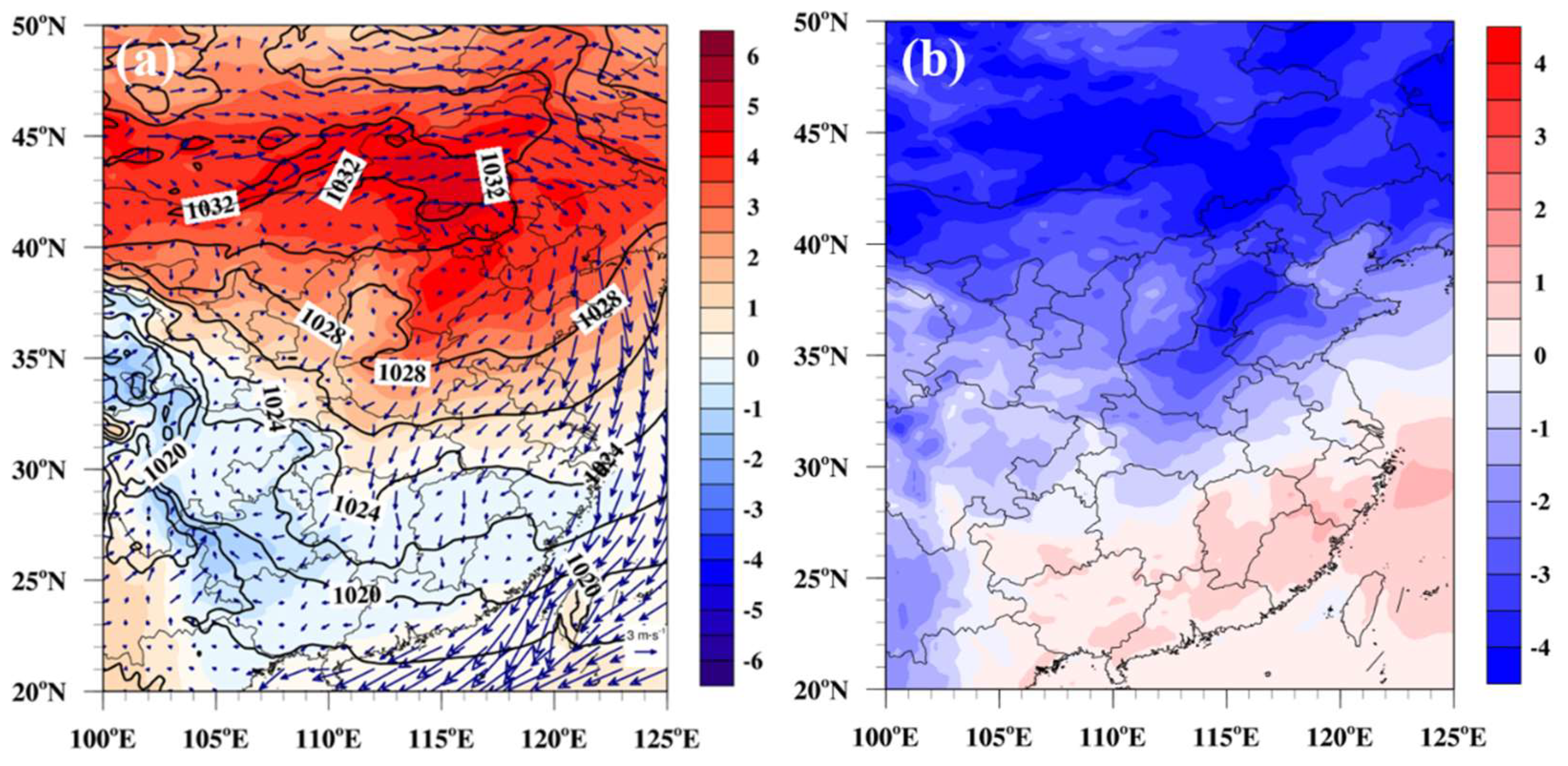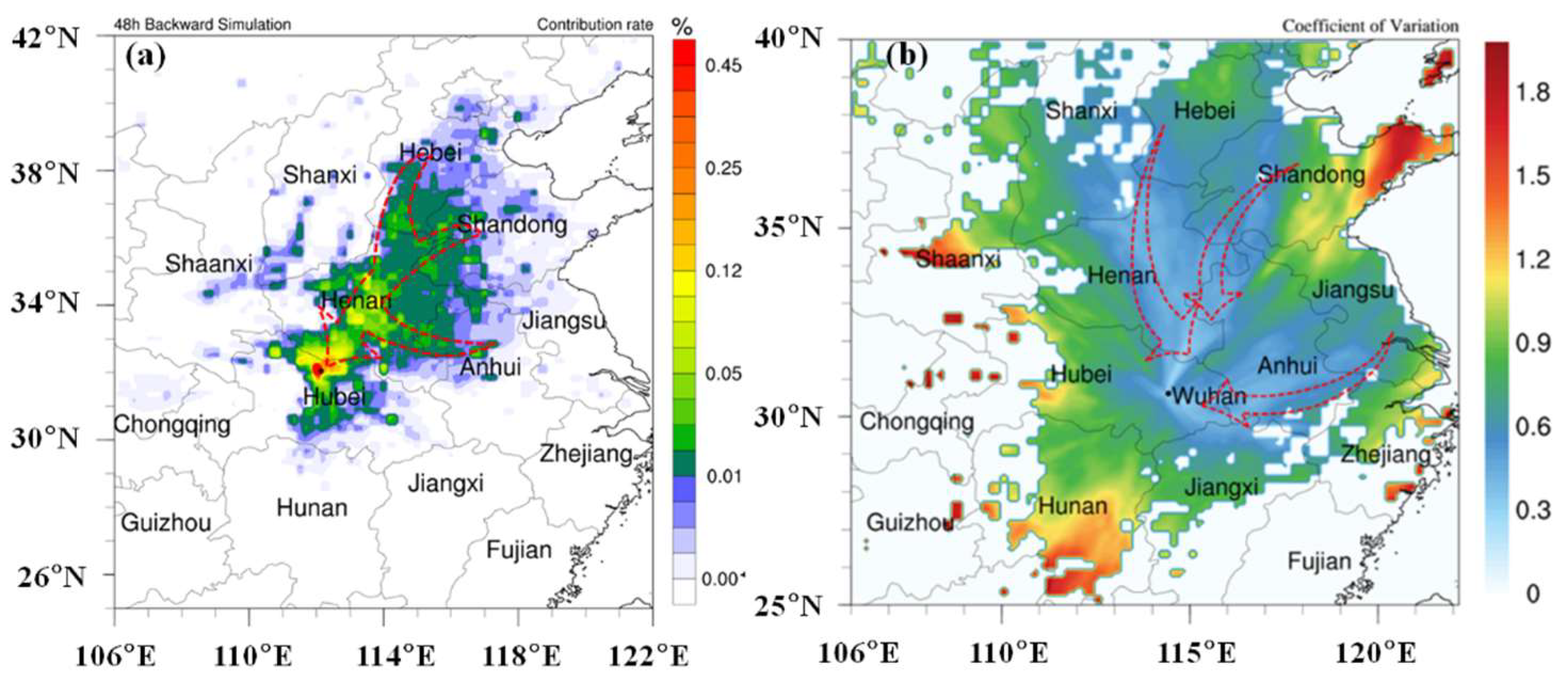Changes in the Distribution Pattern of PM2.5 Pollution over Central China
Abstract
:1. Introduction
2. Materials and Methods
2.1. Data Source
2.2. FLEXPART-WRF Model
2.3. Figure Illustration
3. Results
3.1. Severe PM2.5 Pollution over the Twain-Hu Basin
3.2. Center of Heavy PM2.5 Pollution Events over the Twain-Hu Basin
3.3. Attribution of Heavy Pollution Events in the Twain-Hu Basin
3.4. Assessing the Contribution of Heavy Pollution Events in the Twain-Hu Basin
4. Discussion
5. Conclusions
Supplementary Materials
Author Contributions
Funding
Institutional Review Board Statement
Informed Consent Statement
Data Availability Statement
Acknowledgments
Conflicts of Interest
References
- Zhang, X.; Sun, J.; Wang, Y.; Li, W.; Zhang, Q.; Wang, W.; Quan, J.; Cao, G.; Wang, J.; Yang, Y.; et al. Factors contributing to haze and fog in China. Sci. Bull. 2013, 58, 1178–1187. [Google Scholar]
- Li, Z.; Guo, J.; Ding, A.; Liao, H.; Liu, J.; Sun, Y.; Wang, T.; Xue, H.; Zhang, H.; Zhu, B. Aerosol and boundary-layer interactions and impact on air quality. Natl. Sci. Rev. 2017, 4, 810–833. [Google Scholar] [CrossRef]
- An, Z.; Huang, R.J.; Zhang, R.; Tie, X.; Li, G.; Cao, J.; Zhou, W.; Shi, Z.; Han, Y.; Gu, Z.; et al. Severe haze in Northern China: A synergy of anthropogenic emissions and atmospheric processes. Proc. Natl. Acad. Sci. USA 2019, 116, 8657–8666. [Google Scholar] [CrossRef] [Green Version]
- Chan, C.K.; Yao, X.H. Air pollution in mega cities in China. Atmos. Environ. 2008, 42, 1–42. [Google Scholar] [CrossRef]
- Chang, Y.; Huang, R.J.; Ge, X.; Huang, X.; Hu, J.; Duan, Y.; Zou, Z.; Liu, X.; Lehmann, M. Puzzling haze events in China during the coronavirus (COVID-19) shutdown. Geophys. Res. Lett. 2020, 47, e2020GL088533. [Google Scholar] [CrossRef]
- Callahan, C.W.; Mankin, J.S. The influence of internal climate variability on projections of synoptically driven Beijing haze. Geophys. Res. Lett. 2020, 47, e2020GL088548. [Google Scholar] [CrossRef]
- Du, H.; Li, J.; Wang, Z.; Dao, X.; Guo, S.; Wang, L.; Ma, S.; Wu, J.; Yang, W.; Chen, X.; et al. Effects of regional transport on haze in the North China Plain: Transport of precursors or secondary inorganic aerosols. Geophys. Res. Lett. 2020, 47, e2020GL087461. [Google Scholar] [CrossRef]
- Guo, S.; Hu, M.; Zamora, M.L.; Peng, J.; Shang, D.; Zheng, J.; Molina, M.J.; Zhang, R. Elucidating severe urban haze formation in China. Proc. Natl. Acad. Sci. USA 2014, 111, 17373–17378. [Google Scholar] [CrossRef] [Green Version]
- Wang, H.; Miao, Q.; Shen, L.; Yang, Q.; Wu, Y.; Wei, H. Air pollutant variations in Suzhou during the 2019 novel coronavirus (COVID-19) lockdown of 2020: High time-resolution measurements of aerosol chemical compositions and source apportionment. Environ. Pollut. 2021, 271, 116298. [Google Scholar] [CrossRef]
- Wang, H.; Pei, Y.; Yin, Y.; Shen, L.; Chen, K.; Shi, Z.; Chen, J. Observational Evidence of Lightning-Generated Ultrafine Aerosols. Geophys. Res. Lett. 2021, 48, e2021GL093771. [Google Scholar] [CrossRef]
- Rosenfeld, D.; Sherwood, S.; Wood, R.; Donner, L. Climate effects of aerosol-cloud interactions. Science 2014, 343, 379–380. [Google Scholar] [CrossRef]
- Tao, M.H.; Chen, L.F.; Su, L.; Tao, J.H. Satellite observation of regional haze pollution over the north China plain. J. Geophys. Res. 2012, 117, D12203. [Google Scholar] [CrossRef]
- Wang, N.; Ling, Z.H.; Deng, X.J.; Deng, T.; Lyu, X.P.; Li, T.Y.; Gao, X.R.; Chen, X. Source contributions to PM2.5 under unfavorable weather conditions in Guangzhou City, China. China Adv. Atmos. Sci. 2018, 35, 1145–1159. [Google Scholar] [CrossRef]
- Yu, C.; Zhao, T.; Bai, Y.; Zhang, L.; Kong, S.; Yu, X.; He, J.; Cui, C.; Yang, J.; You, Y.; et al. Heavy air pollution with a unique “non-stagnant” atmospheric boundary layer in the Yangtze River middle basin aggravated by regional transport of PM2.5 over China. Atmos. Chem. Phys. 2020, 20, 7217–7230. [Google Scholar] [CrossRef]
- Zheng, S.; Pozzer, A.; Cao, C.; Lelieveld, J. Long-term (2001–2012) concentrations of fine particulate matter (PM2.5) and the impact on human health in Beijing, China. Atmos. Chem. Phys. 2015, 15, 5715–5725. [Google Scholar] [CrossRef] [Green Version]
- Gui, K.; Che, H.; Wang, Y.; Wang, H.; Zhang, L.; Zhao, H.; Zheng, Y.; Sun, T.; Zhang, X. Satellite-derived PM2.5 concentration trends over Eastern China from 1998 to 2016: Relationships to emissions and meteorological parameters. Environ. Pollut. 2019, 247, 1125–1133. [Google Scholar] [CrossRef] [PubMed]
- Han, R.; Wang, S.; Shen, W.; Wang, J.; Wu, K.; Ren, Z.; Feng, M. Spatial and temporal variation of haze in China from 1961 to 2012. J. Environ. Sci. 2016, 46, 134–146. [Google Scholar] [CrossRef]
- Shen, L.; Wang, H.; Cheng, M.; Ji, D.; Liu, Z.; Wang, L.; Gao, W.; Yang, Y.; Huang, W.; Zhang, R.; et al. Chemical composition, water content and size distribution of aerosols during different development stages of regional haze episodes over the North China Plain. Atmos. Environ. 2021, 245, 118020. [Google Scholar] [CrossRef]
- Xu, X.; Zhao, T.; Liu, F.; Gong, S.L.; Kristovich, D.; Lu, C.; Guo, Y.; Cheng, X.; Wang, Y.; Ding, G. Climate modulation of the Tibetan Plateau on haze in China. Atmos. Chem. Phys. 2016, 16, 1365–1375. [Google Scholar] [CrossRef] [Green Version]
- Zhang, X.Y.; Wang, Y.Q.; Niu, T.; Zhang, X.C.; Gong, S.L.; Zhang, Y.M.; Sun, J. Atmospheric aerosol compositions in China: Spatial/temporal variability, chemical signature, regional haze distribution and comparisons with global aerosols. Atmos. Chem. Phys. 2012, 12, 779–799. [Google Scholar] [CrossRef] [Green Version]
- Zhai, S.; Jacob, D.J.; Wang, X.; Shen, L.; Li, K.; Zhang, Y.; Gui, K.; Zhao, T.; Liao, H. Fine particulate matter (PM2.5) trends in China, 2013–2018: Separating contributions from anthropogenic emissions and meteorology. Atmos. Chem. Phys. 2019, 19, 11031–11041. [Google Scholar] [CrossRef] [Green Version]
- Bai, Y.; Qi, H.; Zhao, T.; Yang, H.; Liu, L.; Cui, C. Analysis of meteorological conditions diurnal variation characteristics of PM2.5 heavy pollution episodes in the winter of 2015 in Hubei province. Acta Meteorol. Sin. 2018, 76, 803–815. [Google Scholar]
- Lu, M.; Tang, X.; Wang, Z.; Wu, L.; Chen, X.; Liang, S.; Zhou, H.; Wu, H.; Hu, K.; Shen, L.; et al. Investigating the transport mechanism of PM2.5 pollution during January 2014 in Wuhan, Central China. Adv. Atmos. Sci. 2019, 36, 1217–1234. [Google Scholar] [CrossRef] [Green Version]
- Shen, L.; Wang, H.; Zhao, T.; Liu, J.; Bai, Y.; Kong, S.; Shu, Z. Characterizing regional aerosol pollution in central China based on 19 years of MODIS data: Spatiotemporal variation and aerosol type discrimination. Environ. Pollut. 2020, 263, 114556. [Google Scholar] [CrossRef]
- Tan, C.; Zhao, T.; Cui, C.; Luo, B.; Zhang, L.; Bai, Y. Characterization of haze pollution over Central China during the past 50 years. China Environ. Sci. 2015, 35, 2272–2280. [Google Scholar]
- Ma, D.; Li, L.; Ju, Y. Climate characteristics of haze days and analysis of summer haze weather event in Hubei province. Environ. Sci. Technol. 2015, 38, 148–153. [Google Scholar]
- Ding, Y.; Liu, Y. Analysis of long-term variations of fog and haze in China in recent 50 years and their relations with atmospheric humidity. Sci. China Earth Sci. 2014, 57, 36–46. [Google Scholar] [CrossRef]
- Li, L.; Wang, Y. What drives the aerosol distribution in Guangdong-the most developed province in Southern China? Sci. Rep. 2014, 4, 5972. [Google Scholar] [CrossRef] [PubMed] [Green Version]
- Xu, X.; Wang, Y.; Zhao, T.; Chen, X.; Meng, Y.; Ding, G. “Harbor” effect of large topography on haze distribution in eastern China and its climate modulation on decadal variations in haze China. Sci. Bull. 2015, 60, 1132–1143. [Google Scholar]
- Bei, N.; Xiao, B.; Meng, N.; Feng, T. Critical role of meteorological conditions in a persistent haze episode in the Guanzhong basin, China. Sci. Total Environ. 2016, 550, 273–284. [Google Scholar] [CrossRef] [PubMed]
- Li, J.; Wang, Z.; Huang, H.; Hu, M.; Meng, F.; Sun, Y.; Wang, X.; Wang, Y.; Wang, Q. Assessing the effects of trans-boundary aerosol transport between various city clusters on regional haze episodes in spring over East China. Tellus B 2013, 65, 20052. [Google Scholar] [CrossRef] [Green Version]
- Jiang, C.; Wang, H.; Zhao, T.; Li, T.; Che, H. Modeling study of PM2.5 pollutant transport across cities in China’s Jing-Jin-Ji region during a severe haze episode in December 2013. Atmos. Chem. Phys. 2015, 15, 5803–5814. [Google Scholar] [CrossRef] [Green Version]
- Chen, Q.; Sheng, L.; Gao, Y.; Miao, Y.; Hai, S.; Gao, S.; Gao, Y. The effects of the trans-regional transport of PM2.5 on a heavy haze event in the Pearl River Delta in January 2015. Atmosphere 2019, 10, 237. [Google Scholar] [CrossRef] [Green Version]
- Wang, H.; Li, J.; Peng, Y.; Zhang, M.; Che, H.; Zhang, X. The impacts of the meteorology features on PM2.5 levels during a severe haze episode in central-east China. Atmos. Environ. 2019, 197, 177–189. [Google Scholar] [CrossRef]
- Gao, Y.; Zhang, M.; Liu, Z.; Wang, L.; Wang, P.; Xia, X.; Tao, M.; Zhu, L. Modeling the feedback between aerosol and meteorological variables in the atmospheric boundary layer during a severe fog–haze event over the North China Plain. Atmos. Chem. Phys. 2015, 15, 4279–4295. [Google Scholar] [CrossRef] [Green Version]
- Zhang, Y.; Ding, A.; Mao, H.; Nie, W.; Zhou, D.; Liu, L.; Huang, X.; Fu, C. Impact of synoptic weather patterns and inter-decadal climate variability on air quality in the North China Plain during 1980–2013. Atmos. Chem. Phys. 2016, 124, 119–128. [Google Scholar] [CrossRef]
- Zhao, X.J.; Zhao, P.S.; Xu, J.; Meng, W.; Pu, W.W.; Dong, F.; He, D.; Shi, Q.F. Analysis of a winter regional haze event and its formation mechanism in the North China Plain. Atmos. Chem. Phys. 2013, 13, 5685–5696. [Google Scholar] [CrossRef] [Green Version]
- Gao, M.; Carmichael, G.R.; Wang, Y.; Saide, P.E.; Yu, M.; Xin, J.; Liu, Z.; Wang, Z. Modeling study of the 2010 regional haze event in the North China Plain. Atmos. Chem. Phys. 2016, 16, 1673–1691. [Google Scholar] [CrossRef] [Green Version]
- Hsu, S.C.; Liu, S.C.; Tsai, F.; Engling, G.; Lin, I.I.; Chou, C.K.C.; Kao, S.J.; Lung, S.C.C.; Chan, C.Y.; Lin, S.C.; et al. High wintertime particulate matter pollution over an offshore island (Kinmen) off southeastern China: An overview. J. Geophys. Res. 2010, 115, D17. [Google Scholar] [CrossRef] [Green Version]
- Kang, H.; Zhu, B.; Gao, J.; He, Y.; Wang, H.; Su, J.; Pan, C.; Zhu, T.; Yu, B. Potential impacts of cold frontal passage on air quality over the Yangtze River Delta, China. Atmos. Chem. Phys. 2019, 19, 3673–3685. [Google Scholar] [CrossRef] [Green Version]
- Brioude, J.; Arnold, D.; Stohl, A.; Cassiani, M.; Morton, D.; Seibert, P.; Angevine, W.; Evan, S.; Dingwell, A.; Fast, J.D.; et al. The Lagrangian particle dispersion model FLEXPART-WRF version 3.1. Geosci. Model. Dev. 2013, 6, 1889–1904. [Google Scholar] [CrossRef] [Green Version]
- Fast, J.D.; Easter, R.C. A Lagrangian partic le dispersion model compatible with WRF. In Proceedings of the 7th Annual WRF User’s Workshop, Boulder, CO, USA, 19–22 June 2006; pp. 19–22. [Google Scholar]
- Stohl, A.; Forster, C.; Frank, A.; Seibert, P.; Wotawa, G. Technical note: The Lagrangian particle dispersion model FLEXPART version 6.2. Atmos. Chem. Phys. 2005, 5, 2461–2474. [Google Scholar] [CrossRef] [Green Version]
- Chen, B.; Xu, X.D.; Zhao, T. Quantifying oceanic moisture exports to mainland China in association with summer precipitation. Clim. Dynam. 2017, 51, 4271–4286. [Google Scholar] [CrossRef]
- Seibert, P.; Frank, A. Source-receptor matrix calculation with a Lagrangian particle dispersion model in backward mode. Atmos. Chem. Phys. 2004, 4, 51–63. [Google Scholar] [CrossRef] [Green Version]
- Zhai, S.; An, X.; Liu, Z.; Sun, Z.; Hou, Q. Model assessment of atmospheric pollution control schemes for critical emission regions. Atmos. Environ. 2016, 124, 367–377. [Google Scholar] [CrossRef]
- Sauvage, B.; Fontaine, A.; Eckhardt, S.; Auby, A.; Boulanger, D.; Petetin, H.; Paugam, R.; Athier, G.; Cousin, J.M.; Darras, S.; et al. Source attribution using FLEXPART and carbon monoxide emission inventories: SOFT-IO version 1.0. Atmos. Chem. Phys. 2017, 17, 15271–15292. [Google Scholar] [CrossRef] [Green Version]
- Stohl, A.; Forster, C.; Eckhardt, S.; Spichtinger, N.; Huntrieser, H.; Heland, J.; Schlager, H.; Wilhelm, S.; Arnold, F.; Cooper, O. A backward modeling study of intercontinental pollution transport using aircraft measurements. J. Geophys. Res. 2003, 108, 1–8. [Google Scholar] [CrossRef]
- Zhu, C.; Kanaya, Y.; Takigawa, M.; Ikeda, K.; Tanimoto, H.; Taketani, F.; Miyakawa, T.; Kobayashi, H.; Pisso, I. FLEXPART v10. 1 simulation of source contributions to Arctic black carbon. Atmos. Chem. Phys. 2020, 20, 1641–1656. [Google Scholar] [CrossRef] [Green Version]
- Zhai, S.; Jacob, D.; Brewer, J.; Li, K.; Moch, J.; Kim, J.; Lee, S.; Lim, H.; Lee, H.; Kuk, S.; et al. Relating geostationary satellite measurements of aerosol optical depth (AOD) over East Asia to fine particulate matter (PM2.5): Insights from the KORUS-AQ aircraft campaign and GEOS-Chem model simulations. Atmos. Chem. Phys. 2021, 21, 16775–16791. [Google Scholar] [CrossRef]
- Zhang, F.; Wang, Y.; Peng, J.; Chen, L.; Sun, Y.; Duan, L.; Ge, X.; Li, Y.; Zhao, J.; Liu, C.; et al. An unexpected catalyst dominates formation and radiative forcing of regional haze. Proc. Natl. Acad. Sci. USA 2020, 11, 3960–3966. [Google Scholar] [CrossRef] [Green Version]
- Holton, J.; Hakim, G. An Introduction to Dynamic Meteorology; Academic Press: New York, NY, USA, 2012. [Google Scholar]
- Wei, P.; Ren, Z.H.; Wang, W.J. Analysis of meteorological conditions and formation mechanisms of lasting heavy air pollution in eastern China in October 2014. Res. Environ. Sci. 2015, 28, 676–683. [Google Scholar]
- Yang, Y.R.; Liu, X.G.; Qu, Y.; An, J.L.; Jiang, R.; Zhang, Y.H.; Sun, Y.L.; Wu, Z.J.; Zhang, F.; Xu, W.Q.; et al. Characteristics and formation mechanism of continuous hazes in China: A case study during the autumn of 2014 in the North China Plain. Atmos. Chem. Phys. 2015, 15, 10987–11029. [Google Scholar] [CrossRef] [Green Version]
- Shen, L.; Zhao, T.; Liu, J.; Wang, H.; Bai, Y.; Kong, S.; Shu, Z. Regional transport patterns for heavy PM2.5 pollution driven by strong cold airflows in Twain-Hu Basin, Central China. Atmos. Environ. 2021, 269, 118847. [Google Scholar] [CrossRef]
- Shen, L.; Zhao, T.; Wang, H.; Liu, J.; Bai, Y.; Kong, S.; Zheng, H.; Zhu, Y.; Shu, Z. Importance of meteorology in air pollution events during the city lockdown for COVID-19 in Hubei Province, Central China. Sci. Total Environ. 2021, 754, 142227. [Google Scholar] [CrossRef]
- Hu, W.; Zhao, T.; Bai, Y.; Kong, S.; Xiong, J.; Sun, X.; Yang, Q.; Gu, Y.; Lu, H. Importance of regional PM2.5 transport and precipitation washout in heavy air pollution in the Twain-Hu Basin over Central China: Observational analysis and WRF-Chem simulation. Sci. Total Environ. 2021, 758, 143710. [Google Scholar] [CrossRef]






| Full Name | Acronym |
|---|---|
| Central and Eastern China | CEC |
| North China Plain | NCP |
| Yangtze River Delta | YRD |
| Sichuan Basin | SB |
| Pearl River Delta | PRD |
| Yangtze River middle basin | YRMR |
| Twain-Hu Basin | THB |
| Heavy pollution event | HPE |
| East Asian monsoon | EAM |
| East Asian winter monsoon | EAWM |
| Year | NCP | YRD | SB | PRD | THB | |||||
|---|---|---|---|---|---|---|---|---|---|---|
| Frequency (%) | Concentration (μg·m−3) | Frequency (%) | Concentration (μg·m−3) | Frequency (%) | Concentration (μg·m−3) | Frequency (%) | Concentration (μg·m−3) | Frequency (%) | Concentration (μg·m−3) | |
| 2014 | 12.8 | 215 | 1.6 | 176 | 1.4 | 169 | 0.0 | -- | 2.7 | 186 |
| 2015 | 10.3 | 231 | 2.1 | 180 | 3.2 | 179 | 0.3 | 154 | 2.9 | 183 |
| 2016 | 9.6 | 221 | 1.4 | 175 | 1.3 | 178 | 0.0 | -- | 1.4 | 191 |
| 2017 | 7.0 | 212 | 1.4 | 189 | 2.4 | 180 | 0.4 | 185 | 1.7 | 186 |
| 2018 | 4.0 | 198 | 1.9 | 184 | 0.9 | 172 | 0.3 | 181 | 1.3 | 188 |
| 2019 | 4.4 | 199 | 0.8 | 172 | 0.5 | 174 | 0.0 | -- | 1.5 | 183 |
Publisher’s Note: MDPI stays neutral with regard to jurisdictional claims in published maps and institutional affiliations. |
© 2021 by the authors. Licensee MDPI, Basel, Switzerland. This article is an open access article distributed under the terms and conditions of the Creative Commons Attribution (CC BY) license (https://creativecommons.org/licenses/by/4.0/).
Share and Cite
Shen, L.; Hu, W.; Zhao, T.; Bai, Y.; Wang, H.; Kong, S.; Zhu, Y. Changes in the Distribution Pattern of PM2.5 Pollution over Central China. Remote Sens. 2021, 13, 4855. https://doi.org/10.3390/rs13234855
Shen L, Hu W, Zhao T, Bai Y, Wang H, Kong S, Zhu Y. Changes in the Distribution Pattern of PM2.5 Pollution over Central China. Remote Sensing. 2021; 13(23):4855. https://doi.org/10.3390/rs13234855
Chicago/Turabian StyleShen, Lijuan, Weiyang Hu, Tianliang Zhao, Yongqing Bai, Honglei Wang, Shaofei Kong, and Yan Zhu. 2021. "Changes in the Distribution Pattern of PM2.5 Pollution over Central China" Remote Sensing 13, no. 23: 4855. https://doi.org/10.3390/rs13234855
APA StyleShen, L., Hu, W., Zhao, T., Bai, Y., Wang, H., Kong, S., & Zhu, Y. (2021). Changes in the Distribution Pattern of PM2.5 Pollution over Central China. Remote Sensing, 13(23), 4855. https://doi.org/10.3390/rs13234855







